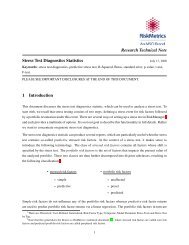Managing Synthetic CDO Tranches using Base Correlations
Managing Synthetic CDO Tranches using Base Correlations
Managing Synthetic CDO Tranches using Base Correlations
You also want an ePaper? Increase the reach of your titles
YUMPU automatically turns print PDFs into web optimized ePapers that Google loves.
<strong>Managing</strong> synthetic <strong>CDO</strong> tranches<br />
<strong>using</strong> base correlations<br />
Robert Stamicar
Agenda<br />
<br />
<strong>Synthetic</strong> <strong>CDO</strong> mechanics<br />
<br />
<strong>Base</strong> correlations under Gaussian copula model<br />
<br />
Stress tests<br />
<br />
Mapping bespoke tranches to standard index tranches<br />
<br />
Interpolation / extrapolation of base correlations<br />
3
<strong>Synthetic</strong> <strong>CDO</strong> mechanics<br />
<br />
losses<br />
Protection buyer pays spread for protection against a portion of portfolio<br />
<br />
Typically, premium is paid as a spread on remaining notional over deal’s life<br />
<br />
Underlying portfolio is a portfolio of single-name CDSs<br />
<br />
Correlation is a key factor for pricing <strong>CDO</strong>s<br />
Correlation does not affect the portfolio expected loss,<br />
But redistributes losses around the capital structure<br />
4
<strong>Synthetic</strong> <strong>CDO</strong> Mechanics<br />
Protection buyer<br />
Protection Seller<br />
Dealer<br />
Tranche spread<br />
Loss payments<br />
<strong>CDO</strong><br />
Tranche<br />
5
Protection buyer can hedge by selling individual<br />
protection<br />
Dealer sells<br />
protection<br />
Protection buyer<br />
Protection Seller<br />
Name 1<br />
Name 2<br />
.<br />
.<br />
.<br />
Dealer<br />
Tranche spread<br />
Loss payments<br />
<strong>CDO</strong><br />
Tranche<br />
b<br />
a<br />
Name N<br />
Credit<br />
Collateral Pool<br />
6
Tranche Pricing (standard version)<br />
<br />
CDS price: deterministic discount factors, hazard rates<br />
<br />
S<strong>CDO</strong> price: deterministic discount factors, hazard rates<br />
<br />
What about loss distribution assumption<br />
One-factor Gaussian copula is the market standard<br />
7
Agenda<br />
<br />
<strong>Synthetic</strong> <strong>CDO</strong> mechanics<br />
<br />
<strong>Base</strong> correlations under Gaussian copula model<br />
<br />
Stress tests<br />
<br />
Mapping bespoke tranches to standard index tranches<br />
<br />
Interpolation / extrapolation of base correlations<br />
8
Gaussian Copula Model<br />
<br />
<br />
Standard Model Assumptions: One-factor Gaussian copula model<br />
F<br />
i<br />
( t)<br />
= Pr[ τ<br />
i<br />
< t]<br />
⇔ Φ(<br />
Zi<br />
) = F(<br />
ti<br />
)<br />
Conceptual two name example<br />
Z<br />
i<br />
= ρ Z + 1− ρε<br />
i<br />
2.5<br />
Correlated normals<br />
100<br />
Correlated default times<br />
2<br />
1.5<br />
1<br />
0.5<br />
t<br />
t<br />
1<br />
2<br />
=<br />
=<br />
F<br />
F<br />
−1<br />
1<br />
−1<br />
2<br />
( Φ(<br />
z<br />
( Φ(<br />
z<br />
1<br />
2<br />
))<br />
))<br />
90<br />
80<br />
70<br />
60<br />
0<br />
50<br />
-0.5<br />
40<br />
-1<br />
30<br />
-1.5<br />
20<br />
-2<br />
10<br />
-2.5<br />
-3 -2 -1 0 1 2 3<br />
0<br />
0 5 10 15 20 25 30 35 40 45 50<br />
9
Gaussian Copula Model (con’t)<br />
<br />
<br />
Standard Model Assumptions: One-factor Gaussian copula model<br />
F<br />
i<br />
( t)<br />
= Pr[ τ<br />
i<br />
< t]<br />
⇔ Φ(<br />
Zi<br />
) = F(<br />
ti<br />
)<br />
Two name example: condition on the market factor<br />
Z<br />
i<br />
= ρ Z + 1− ρε<br />
i<br />
X<br />
1<br />
⎧1<br />
= ⎨<br />
⎩0<br />
prob p ( z)<br />
1<br />
prob (1 − p ( z))<br />
1<br />
X<br />
2<br />
⎧1<br />
= ⎨<br />
⎩0<br />
prob p<br />
2<br />
( z)<br />
prob (1 − p<br />
2<br />
( z))<br />
Loss Distribution<br />
⎧0<br />
⎪<br />
l1<br />
L = ⎨<br />
⎪l2<br />
⎪<br />
⎩l1<br />
+ l<br />
2<br />
(1 − p ( z))(1<br />
− p<br />
p ( z)(1<br />
− p<br />
1<br />
2<br />
p ( z)<br />
p<br />
1<br />
1<br />
2<br />
2<br />
1<br />
( z)<br />
2<br />
( z))<br />
p ( z)(1<br />
− p ( z))<br />
( z))<br />
Tranche Pricing<br />
Derived from portfolio loss distribution<br />
⎧0<br />
L < a<br />
⎪<br />
L T<br />
= ⎨L<br />
− a a < L < b<br />
⎪<br />
⎩b<br />
− a b < L<br />
<br />
Many names …<br />
Use FFT (fast Fourier transforms) or recursive method (Andersen, Sidenius, Basu (2003)) to<br />
compute probabilities<br />
10
Compound correlations are problematic<br />
<br />
S<strong>CDO</strong> price is a function of:<br />
Asset correlation<br />
CDS spreads<br />
Maturity<br />
Recovery rates<br />
<br />
Compound correlation: Asset correlation inferred from S<strong>CDO</strong> price<br />
Multiple solutions for mezzanine tranches<br />
How do you price a tranche with non-standard attachment/detachment points<br />
11
<strong>Base</strong> correlation framework<br />
<br />
Each tranche is decomposed into two “virtual” equity tranches<br />
Incorporate entire capital structure<br />
V<br />
= V<br />
( s,<br />
ρb)<br />
−V0,<br />
( s,<br />
ρ )<br />
a, b 0, b<br />
a a<br />
<br />
Why<br />
Some analogy with pricing equity options with multiple strikes<br />
Consistency across a fixed maturity (inconsistent across different tenors)<br />
More importantly, empirical evidence suggests that base correlations provide better<br />
sensitivities than compound correlations.<br />
<br />
From standard index tranches we can bootstrap base correlations<br />
12
Agenda<br />
<br />
<strong>Synthetic</strong> <strong>CDO</strong> mechanics<br />
<br />
<strong>Base</strong> correlations under Gaussian copula model<br />
<br />
Stress tests<br />
<br />
Mapping bespoke tranches to standard index tranches<br />
<br />
Interpolation / extrapolation of base correlations<br />
13
Stress tests<br />
<br />
<br />
<br />
<strong>Base</strong> correlations can be stressed directly or indirectly<br />
Indirect stresses involve market observables:<br />
Upfront fee of equity and junior tranches<br />
Tranche fair spreads<br />
Stresses should propagate up the capital structure<br />
Each stress shift involving market quotes is translated into a base correlation shift<br />
<br />
Example:<br />
0-3% Upfront fee increases bootstrap: calculate ρ 3<br />
’<br />
3-7% Tranche fair spread increases bootstrap: calculate ρ 7<br />
’(use ρ 3<br />
’)<br />
7-10% No stress is applied bootstrap: ρ 10<br />
’(use ρ 7<br />
’)<br />
14
Recent market volatility: US subprime crisis<br />
<br />
In late February, credit problems emerged in US subprime mortgages<br />
6000<br />
ABX.HE.07-1 BBB spread<br />
BBB Spread<br />
5000<br />
4000<br />
3000<br />
Price deterioration:<br />
June 1: 75%<br />
July 31: 40%<br />
2000<br />
1000<br />
0<br />
Jan07 Mar07 May07 Jul07 Sep07<br />
15
Subprime crisis has spread to …<br />
Leveraged loans and credit markets<br />
CDX.NA.IG S8 index, 0-3% upfront fee<br />
90<br />
0.7<br />
Index (bp)<br />
80<br />
70<br />
60<br />
50<br />
40<br />
30<br />
20<br />
10<br />
0.6<br />
0.5<br />
0.4<br />
0.3<br />
0.2<br />
0.1<br />
Upfront fee<br />
Date Index Upfront fee<br />
June 1 34 bp 23%<br />
July 31 76 bp 48%<br />
Aug 3 81 bp 47%<br />
0<br />
Nov06 Jan07 Mar07 May07 Jul07 Sep07<br />
0<br />
16
Implied values: <strong>Base</strong> correlation of equity tranche<br />
CDX.NA.IG S8 index, 3% base correlation<br />
90<br />
0.3<br />
Index (bp)<br />
80<br />
70<br />
60<br />
50<br />
40<br />
30<br />
0.25<br />
0.2<br />
0.15<br />
0.1<br />
<strong>Base</strong> correlation<br />
Date Index Correlation<br />
June 1 34 bp 14%<br />
July 31 76 bp 20%<br />
Aug 3 81 bp 26%<br />
20<br />
10<br />
0.05<br />
0<br />
Nov06 Jan07 Mar07 May07 Jul07 Sep07<br />
0<br />
17
Stress Test Example for CDX.NA.IG S8<br />
July 25-26, 2007<br />
Market observables (relative movements)<br />
CDX spread: +23%<br />
Upfront fee: +15%<br />
Implied movement of base correlation<br />
0-3% tranche: +17%<br />
<br />
Recall a decrease in equity price can be caused by<br />
Explained portion: Increase CDX spread (increase in default probabilities)<br />
Unexplained portion: Decrease in correlation (“sporadic” defaults will increase)<br />
18
Apply stress test<br />
Assume stress applies to a “calm” market environment<br />
Explicit base correlation shift<br />
<strong>Base</strong> correlation<br />
stress increases price<br />
Positions<br />
Tranche<br />
notional ($M)<br />
Upfront<br />
price ($M)<br />
DV01<br />
($000)<br />
Index<br />
($000)<br />
<strong>Base</strong> correl<br />
($000)<br />
Market<br />
spreads ($000)<br />
Sell 0-3% 3 0.73 -29 -217 64 -141<br />
Sell 3-7% 4 0.00 -10 -82 -2 -78<br />
Index 50 0.00 -22 -183 0 -183<br />
Implicit base correlation shift<br />
Positions<br />
Tranche<br />
notional ($M)<br />
Upfront<br />
price ($M)<br />
DV01<br />
($000)<br />
Index<br />
($000)<br />
<strong>Base</strong> correl<br />
$000)<br />
Market<br />
spreads ($000)<br />
Sell 0-3% 3 0.73 -29 -217 -108 -349<br />
Sell 3-7% 4 0.00 -10 -82 -63 -188<br />
Index 50 0.00 -22 -183 0 -183<br />
19
So which stress test makes sense<br />
<br />
Is the base correlation moving in the wrong direction<br />
<strong>Base</strong> correlation explains the unexpected movement in prices<br />
In the actual market scenario (July 25-26), the Gaussian copula model<br />
overestimates the losses<br />
Adjust model by increasing correlation<br />
In fact, during this period of systemic risk, investors sold equity protection and<br />
bought index protection.<br />
This pushed base correlations up<br />
<br />
Hedging contributed to increased volatility (and accentuated spread widening)<br />
Hedge ratios broke down in high volatility environment<br />
Models used by dealers underestimated tranche deltas. Dealers rebalanced hedge<br />
ratios by buying index protection (to hedge bought mezzanine protection)<br />
CPDO (constant proportion debt obligations): as index spread widened, dealers<br />
needed to buy protection<br />
20
<strong>Base</strong> correlation as a risk factor<br />
Volatility versus price level<br />
<br />
iTraxx Europe (Jan-05 to Sept-07)<br />
Vol from absolute difference<br />
Vol from relative difference<br />
0.025<br />
0.1<br />
0.09<br />
0.02<br />
0.08<br />
0.07<br />
0.015<br />
0.06<br />
0.01<br />
0.005<br />
0.05<br />
0.04<br />
0.03<br />
0.02<br />
0<br />
0.1 0.15 0.2 0.25<br />
0.01<br />
0.1 0.15 0.2 0.25<br />
21
Agenda<br />
<br />
<strong>Synthetic</strong> <strong>CDO</strong> mechanics<br />
<br />
<strong>Base</strong> correlations under Gaussian copula model<br />
<br />
Stress tests<br />
<br />
Mapping bespoke tranches to standard index tranches<br />
<br />
Interpolation / extrapolation of base correlations<br />
22
Pricing bespoke tranches under the base correlation<br />
framework<br />
<br />
What’s a bespoke tranche<br />
Non-standard custom <strong>CDO</strong> tranche<br />
The investor chooses:<br />
Reference portfolio<br />
Attachment/detachment points<br />
Maturity<br />
Other details<br />
Term used to distinguish S<strong>CDO</strong> tranches from (liquid) index tranches<br />
Typically, refers to a different reference portfolio<br />
<br />
It’s illiquid<br />
Can we use standard tranche indices to price and capture risk for bespokes<br />
Standard index tranches:<br />
CDX 0-3%, 3-7%, 7-10%, 10-15%, 15-30%<br />
iTraxx 0-3%, 3-6%, 6-9%, 9-12%, 12-22%<br />
23
Mapping base correlations between bespoke and<br />
index portfolios<br />
<br />
Given a base correlation surface ρ Ι<br />
(X,T), can we determine ρ Β<br />
(X,T)<br />
Idea is to find an equivalent base tranche on a standard index with strike X I<br />
X<br />
a<br />
B<br />
X I<br />
<br />
This mapping gives the bespoke base correlations:<br />
24
Mapping base correlations:<br />
Mechanics after “equivalent” strike is determined<br />
<br />
Consider a risky bespoke portfolio:<br />
Bespoke portfolio<br />
Index portfolio<br />
b<br />
ρ I<br />
a<br />
b’<br />
a’<br />
a’ b’<br />
ρ ( b)<br />
= ρ ( b')<br />
B<br />
ρ ( a)<br />
= ρ ( a')<br />
B<br />
I<br />
I<br />
25
<strong>Base</strong> correlation mapping methods<br />
Finding an “equivalent” strike<br />
<br />
Method 1: Degenerate Case<br />
X = ρ ( X , T)<br />
= ρ ( X , T)<br />
I<br />
X B<br />
B<br />
I<br />
<br />
Example<br />
20%<br />
10% 10%<br />
Bespoke<br />
Standard<br />
RR = 0% RR = 50%<br />
26
Mappings<br />
<br />
Method 2: ATM mapping<br />
Adjusts for recovery rates<br />
Two tranches are equivalent if their strikes lie in the same region of the capital structure with respect to E[PL]<br />
But dispersion is not captured<br />
<br />
Method 3: Probability Matching<br />
Two tranches are priced with the same correlation if they have the same probability of being wiped out<br />
Problem: Discrete losses need to be smooth cumulative loss distribution<br />
27
Method 4: Expected Tranche Loss Proportion<br />
Adjusting loss distribution implied by one-factor Guassian copula<br />
<br />
Method 5: Spread Matching<br />
Assume bespoke and index equivalent have the same spread<br />
28
How do the mappings compare<br />
<br />
Consider the following test case (from Baheti and Morgan(2007)):<br />
Bespoke: iTraxx S6<br />
Index: CDX IG7<br />
29
Comparison of mappings for iTraxx S6:<br />
January 31, 2007<br />
Source: Lehman Brothers<br />
30
<strong>Base</strong> correlation skew for iTraxx S6 5Y<br />
Source: Lehman Brothers<br />
31
Heterogeneous portfolios<br />
Can we find a suitable index portfolio<br />
<br />
Last example worked well since both the bespoke and index portfolios were<br />
fairly similar (both contained investment grade names)<br />
<br />
What about dispersion Suppose bespoke portfolio contains high yield and<br />
investment credits<br />
Map to multiple indices<br />
Find greatest overlap in names across appropriate indices<br />
Extend one-factor Gaussian copula model so that we can map a bespoke portfolio<br />
to multiple index portfolios<br />
32
Interpolation and extrapolation of base correlations<br />
<br />
Price is extremely sensitive to the slope of the base correlation curve<br />
Abrupt change in slope can lead to arbitrage violations<br />
<br />
How should we interpolate to maintain no-arbitrage framework<br />
<br />
How should we extrapolate<br />
<br />
<strong>Base</strong> correlation curve is monotonically increasing<br />
Equity tranches are riskier than constant correlation predicts<br />
33
Consider linear interpolation<br />
iTraxx 18-Sep-2007<br />
1<br />
0.9<br />
0.8<br />
0.7<br />
1200<br />
1000<br />
800<br />
Fair spreads of tranchlets<br />
<strong>Base</strong> Correlation<br />
0.6<br />
0.5<br />
0.4<br />
Fair spread (bp)<br />
600<br />
400<br />
Arbitrage<br />
Negative spreads<br />
0.3<br />
0.2<br />
200<br />
0.1<br />
0<br />
0<br />
0 0.05 0.1 0.15 0.2 0.25 0.3 0.35<br />
Strike<br />
0 0.05 0.1 0.15 0.2 0.25 0.3 0.35<br />
Strike<br />
<br />
<br />
Increase X, fair spread decreases<br />
Low gradient, fair spread increases<br />
34
Instead, interpolate expected tranche loss<br />
Parcel and Wood (2007):<br />
<br />
Easier to formulate no-arbitrage conditions with expected tranche loss<br />
ETL(<br />
X,<br />
ρX<br />
) = ∫ Pr( L > s)<br />
ds<br />
0<br />
∂ETL(<br />
X,<br />
ρX<br />
)<br />
Pr( L > x)<br />
=<br />
> 0<br />
∂X<br />
2<br />
∂ ETL(<br />
X,<br />
ρX<br />
)<br />
fL(<br />
x)<br />
= −<br />
2<br />
∂X<br />
X<br />
Eliminates negative spreads<br />
Eliminates fair spreads<br />
increasing<br />
<br />
Turn extrapolation of base correlations into an interpolation exercise<br />
Expected tranche loss of zero strike is zero<br />
Expected tranche loss of 100% detachment point is equal to the expected portfolio<br />
loss<br />
35
Summary<br />
<br />
<br />
<strong>Base</strong> correlation are useful<br />
Fairly straightforward to implement<br />
Entire capital structure is incorporated (for the same maturity)<br />
Stress tests<br />
Provide flexibility by allowing shifts of market observables<br />
Fair spreads, upfront fees<br />
<br />
Expected tranche loss is useful:<br />
Pricing of bespoke tranches<br />
Interpolation / extrapolation of base correlations<br />
<br />
References<br />
Baheti and Morgan (2007): <strong>Base</strong> correlation mapping, Lehman Brothers<br />
Parcell and Wood (2007): Wiping the smile off your base (correlation curve),<br />
Derivatives Fitch<br />
36

















